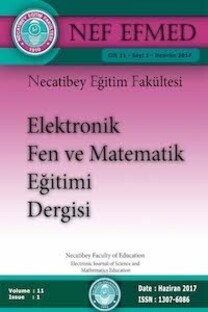INVESTIGATION OF CLASSIFICATION INDICES ON TIMSS-2015 MATHEMATIC-SUBTEST THROUGH BAYESIAN AND NONBAYESIAN ESTIMATION METHODS
BAYESIAN VE NONBAYESIAN KESTİRİM YÖNTEMLERİNE DAYALI OLARAK SINIFLAMA İNDEKSLERİNİN TIMSS2015 MATEMATİK TESTİ ÜZERİNDE İNCELENMESİ
___
Altun, M. (2010). Matematik Öğretimi. Bursa: Pegem Akademi.Büyüköztürk , S. Çakan, M., Tan, S., & Atar, H. Y. (2014). TIMSS 2011 ulusal matematik ve fen raporu 8. sınıflarRetrieved fromhttp://timss.meb.gov.tr/wp-content/uploads/TIMSS2011-8-Sinif.pdf
Barnett, D. W., & Macmann, G. M. (1992). Decision reliability and validity: contribution and limitations of alternative assessment systems. The Journal of Special Education. 25(4), 431-452.
Bourque, M. L., Goodman, D., Hambleton, R. K., & Han, N. (2004). Reliability estimates for the ABTE tests in elementary education, professional teaching knowledge, secondary mathematics and English/language arts (Final Report). Leesburg, VA: Mid-Atlantic Psychometric Services.
Cizek, G.J. ve Bunch, M. B. (2007). Standard Setting: A Guide to Establishing and Evaluating Performance Standards on Tests. London: Sage.
Cohen J (1960). A Coefficient of Agreement for Nominal Scales. Educational and Psychological Measurement, 20(1), 37–46.
Cohen, J. (1988). Statistical power analysis for the behavioral sciences (2nd ed.). Hillsdale, NJ: Lawrence Earlbaum Associates.
Ercikan, K., & Julian, M. (2002). Classification accuracy of assigning student performance to proficiency levels: Guidelines for assessment design. Applied Measurement in Education, 15, 269-294.
Fraenkal, J. R., Wallen, N. E., & Hyun, H. H. (2008). How to design and evaluate research in education (7th ed.). New York: M Graw Hill.
Guo, F. (2006). Expected classification accuracy using the latent distribution. Practical assessment. Research & Evaluation, 11(6), 1-9.
Hambleton, R. K, & Novick, M. (1973). Toward an integration of theory and method for criterion-referenced tests. Journal of Educational Measurement, 10(3), 159-170.
Huynh, H. (1976). On the reliability of decisions in domain-referenced testing. Journal of Educational Measurement, 13, 253-264.
Kadane, J. B. (2015). Bayesian methods for prevention research. Prevention Science, 16, 1017– 1025. 10.1007/s11121-014-0531-x
Lathrop, Q. N., & Cheng, Y. (2014). A nonparametric approach to estimate classification accuracy and consistency. Journal of Educational Measurement, 51, 318-334.
Lee, W., Hanson, B. A., & Brennan, R. L. (2000). Procedures for computing classification consistency and accuracy ındices with multiple categories. ACT : Inc, Research Report.
Lee, S. Y., & Song, X. Y. (2004). Evaluation of the Bayesian and maximum likelihood approaches in analyzing structural equation models with small sample sizes. Multivariate Behavioral Research, 39, 653–686. DOI: 10.1207/s15327906mbr3904_4
Lee, W. (2010). Classification consistency and accuracy for complex assessments using item response theory. Journal of Educational Measurement, 47, 1-17.
Livingston SA, Lewis C (1995). “Estimating the Consistency and Accuracy of Classifications Based on Test Scores.” Journal of Educational Measurement, 32(2), 179–197.
Mislevy, R. (1986). Bayes modal estimation in item response models. Psychometrika, 51, 177– 195 Seong, T. J., Kim, S. H. & Cohen, A. S. (1997, March). A comparison of procedures for ability estimation under the graded response model. Paper presented at the Annual Meeting of the American Educational Research Association. Chicago
Pallant, J. (2007). SPSS Survival Manual: A Step by Step Guide to Data Analysis using SPSS for Windows. New York: Open University Press.
Rudner, L. M. (2001). Computing the expected proportions of misclassified examinees. Practical Assessment Research & Evaluation, 7(14). Available online: http://pareonline.net/getvn.asp?v=7&n=14
Rudner, L. M. (2005). Expected classification accuracy. Practical Assessment Research & Evaluation, 10(13). Available online: http://pareonline.net/getvn.asp?v=10&n=13.
Sireci, S. G., Robin, F., & Patelis, T. (1999). Using cluster analysis to facilitate standard setting. Applied Measurement in Education, 12, 301-325.
Subkoviak, M. J. (1976). Estimating reliability from a single administration of a criterionreferenced test. Journal of Educational Measurement, 13, 265-276.
Swaminathan H, Hambleton RK, Algina J (1974). “Reliability of Criterion-Referenced Tests: A Decision-Theoretic Formulation.” Journal of Educational Measurement, 11(4), 263–267.
Yang, X., Poggio, J. C., &Glasnapp, D. R. (2006). Effects of estimation bias on multiplecategory classificationwith an IRT-baesd adaptive classification procedure. Educational and Psychological Measurement,31, 275-291.
Wyse, A. E., & Hao, S. (2012). An evaluation of item response theory classification accuracy and consistency indices. Applied Psychological Measurement, 36, 602-624.
Zhang, S., Du, J., Chen, P., Xin, T., & Chen, F. (2017). Using Procedure Based on Item Response Theory to Evaluate Classification Consistency Indices in the Practice of LargeScale Assessment. Frontiers in Psychology, 8, 1676. http://doi.org/10.3389/fpsyg.2017.01676
- ISSN: 1307-6086
- Yayın Aralığı: 2
- Başlangıç: 2007
- Yayıncı: Balıkesir Üniv. Necatibey Eğitim Fak.
ERKAN ÇALIŞKAN, SEMİRHAN GÖKÇE, Nezih ÖNAL
Kübra EFE ÇETİN, Sevinç MERT UYANGÖR
7.Sınıf Öğrencilerinin Dörtgenler Konusundaki İspat Seviyelerinin İncelenmesi
Zülfiye ZEYBEK ŞİMŞEK, Aslıhan ÜSTÜN
İlkokul Fen Bilimleri Ders Kitaplarında Kavram Yanılgılarına Neden Olabilecek Sözel ve Görsel İçerik
Türkiye’de Matematik Ders Kitaplarına Yönelik Yapılan Araştırmalardaki Eğilimler
